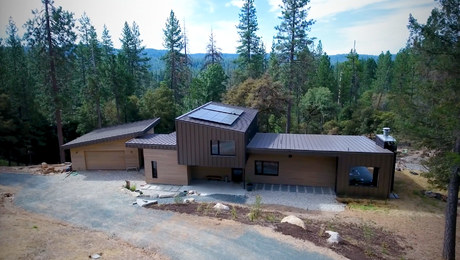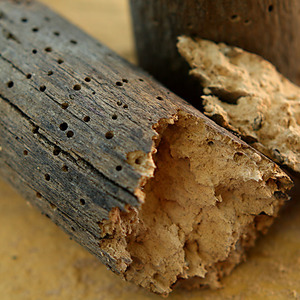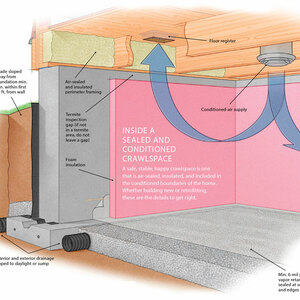Started a thread about baseboards and tile…
In the end I decided that the sheet flooring plus 1/4 inch plywood had to go. As it turned out, a good choice but for the wrong reason. On removing, I noticed that the original subfloor was rotted on each side of the patio door. Following up, the frame of the patio door on the outside is rotted thru as well. Obviously, the door requires replacement as well as the defective subfloor.
As a novice at this (couldn’t you guess?) this has sort of left me fresh out of ideas. While I can do tile ok structural is a new one for me. Willing to take it slow but what I really need is some ideas on where to look for the leak. I figure something else caused the patio door frame to leak that in turn caused the subfloor area to rot… etc but what is the original error? Where should I look?
Looks like ok construction to me (no expert tho). What are the inherent weaknesses or whatever. Exterior is vinyl siding.
would also appreciate what to look for in a replacement door? Want something above minimal but all the bells and whistles aren’t essential either.
Appreciate that a lot of guessing (educated tho unlike my own musings) is likely here but any insight is better than where I am now.


















Replies
I have seen a ton of water damage caused by improper caulking of j channel, flashing over a patio door is also very important, however many guys don't feel it is important anymore, sadly.
Dunc, mind if I ask where you're from?
Eastern Ontario, Canada
Where does the door lead? Is it a level transition or a change in elevation? Are there any paths from above for water to travel? Is capillary action a possible culprit? I may be wrong, but from what I've encountered, rot happens to wood when moisture is allowed to enter and then escape in a cyclical manner. If there is a fluctuation of moisture(possibly more moisture than less) the wood will whither.
Door leads to the kitchen. Kitchen floor (subfloor, actually) is 3-4 inches above the deck. The patio door frame is rotted on the exterior at the two top corners although it appears more severe at the top left (when outside facing the door). The interior floor rot is more advanced on the same side.
On closer inspection above the patio door exterior is a piece of plastic that slides under the siding and then curls up. It looks a bit like the letter "J". Each end of this has been plugged with a glob of caulk. I dont know when it was placed (I am 3rd owner, house is ~16 yrs old). This appears to result in a mini-dam and lake effect although it doesn't have the depth in the bowl of the "J" to allow the water level to build very high. Wondering what layers of building materials - and in what order - should make up the sandwich above, at sides and bottom of patio door. I assume it is a multi-layer approach in that each successive piece of the puzzle overlaps the previous one(s). Should the door frame, after installation be caulked all around?Other thoughts?Thanks for all your assistance
Is the door itself damaged or the framing around it? Could you remove the door unit, replace trashed wood and re-install? Rough outline is:
1-frame rough opening; lay in pan gasket (self stick wide bitumen tape is best); lay in aluminum pan bent to fit; wrap sides of rough opening(RO) with more self stick tape lapping down over the lower pan-slice housewrap at the header height and tuck sidewraps underneath if you can; wrap the top- insure all wrapping extends into the RO and then out over the housewrap except the top piece along its top edge which should be tucked under the house wrap; caulk to beads along the door RO's threshold; reset door unit and nail off; if the door unit has flanges you could wrap again in a similar manner with narrower strips; install drip cap along head, tucked under housewrap again; tape off drip cap; install j-channel set into a thin bead of caulk along the door unit or install casing trim (note head piece of casing should also have a dripcap) followed by j-channel and then siding; caulk the seam between j-channel and casing/door unit neatly.
That I think is a good basic run-down, I'm sure others will have thoughts. As far as the framing repair we may need a pic or two. Also don't caulk under the door threshold along the exterior or under the drip capping. Water runs downhill, if it gets in give it a way to easily get back out. If just the subfloor is rotted replace that, rotten joists may need sistering.
Is it too late to carefully lay the floor back and cover it with a throw rug? :>(
Sorry, I'm just shuddering at the size of the pile you've stepped in. From a simple tile job, you've gone directly to get a crash course in framing, door hanging, leak detection and waterproofing. That's a tall order for a beginner, and you may want to bring in some help. Otherwise, just proceed with common sense.
The leak most likely started around the door, so check that first. If wet or damaged area goes higher up befind the siding, it could be getting in anywhere, including the roofline/gutter area -or even a plumbing leak.
The quickest way to replace the door here, once the framing is sound, is by getting a prehung door with the hardware included and make sure it's properly shimmed and plumb.
Flashing systems can be tricky, though, so get a book or at least one of those free pamphlets they give away at ace hardware. Obviously, you don't want to repeat any mistakes where exterior work is involved. Good luck.
Edited 4/7/2006 10:31 am ET by saulgood
What mbdyer said. My additional thoughts about his post are that he nailed it 100%.
I'm assuming by patio door you mean a slider. To help you visualize what is likely going on here, look at the outside of the door sill where the slider channel is exposed (the part the the operating door panel slides over when you open the door). It's like a pan that can hold water every time it rains.
There should be a at least a couple of tiny drain holes in each corner that lead out. These will clog. Also, no matter what you do to seal the side jambs to the sill, it will eventually leak in the corners.
If there is no head flashing, water will eventually hit the head jamb, flow down the sides and land in the corners. Bottom line, assume you are guaranteed to have water under the sill of the slider. As mbdyer said, make sure you have a pan flashing below that will catch that water and send it back out.
I have a slider on the top floor of my house that generally performs well, but every nor'easter the room below looks as if there's a roof leak if I don't keep those little drains I was talking about perfectly clear of any debris. Whoever installed it (before I bought the place) thought flashing was a pervert crime. ;-)
"Let's get crack-a-lackin" --- Adam Carolla